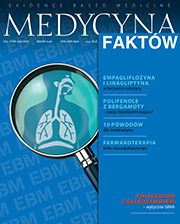Anti-ischaemic properties of new β-blockers on the example of nebivolol Review article
Main Article Content
Abstract
β-blockers are drugs widely used in the treatment of coronary artery disease. The principal mechanisms of action of this class of drugs are: reduction of heart rate and myocardial contractility and decrease in systemic blood pressure, which in turn translates into a decrease in myocardial oxygen demand, improved control of angina symptoms and improved patients prognosis. Properties mentioned above were already possessed by the first generation of β-blockers. However, next generations of β-blockers brought modifications aiming to improve the safety profile, reduce adverse effects and strengthen the desired effects of therapy. As a result, the impact of β-blockers on: coronary flow regulation, lipid metabolism and insulin resistance have improved. The following article elaborates scientific evidence about the beneficial effects of third generation of β-blockers in the treatment of coronary artery disease. Nebivolol has recently been registered for use in stable coronary artery disease, hence will be used as an example of the third class of β-blockers in this article.
Article Details
Copyright © by Medical Education. All rights reserved.
References
2. Maffei A., Lembo G.: Nitric oxide mechanisms of nebivolol. Ther. Adv. Cardiovasc. Dis. 2009; 3(4): 317-327.
3. Howlett J.G.: Nebivolol: vasodilator properties and evidence for relevance in treatment of cardiovascular disease. Can. J. Cardiol. 2014; 30(5): S29-37.
4. Czuriga I., Riecansky I., Bodnar J. et al.: Comparison of the new cardioselective beta-blocker nebivolol with bisoprolol in hypertension: the Nebivolol, Bisoprolol Multicenter Study (NEBIS). Cardiovasc. Drugs Ther. 2003; 17(3): 257-263.
5. Feigl E.O.: Coronary physiology. Physiol. Rev. 1983; 63(1): 1-205.
6. Moncada S., Higgs E.A.: The discovery of nitric oxide and its role in vascular biology. Br. J. Pharmacol. 2006; 147(suppl. 1): S193-S201.
7. Bassenge E., Heusch G.: Endothelial and neuro-humoral control of coronary blood flow in health and disease. Rev. Physiol. Biochem. Pharmacol. 1990; 116: 77-165.
8. Di Carli M.F., Tobes M.C., Mangner T. et al.: Effects of cardiac sympathetic innervation on coronary blood flow. N. Engl. J. Med. 1997; 336(17): 1208-1215.
9. Hoffman J.I.: Maximal coronary flow and the concept of coronary vascular reserve. Circulation 1984; 70(2): 153-159.
10. Wilson R.F., Laxson D.D.: Caveat emptor: a clinician’s guide to assessing the physiologic significance of arterial stenoses. Cathet. Cardiovasc. Diagn. 1993; 29(2): 93-98.
11. Dimitrow P.P., Galderisi M., Rigo F.: The non-invasive documentation of coronary microcirculation impairment: role of transthoracic echocardiography. Cardiovasc. Ultrasound. 2005; 3: 18.
12. Togni M., Vigorito F., Windecker S. et al.: Does the beta-blocker nebivolol increase coronary flow reserve? Cardiovasc. Drugs Ther. 2007; 21(2): 99-108.
13. Schneider D.J., Sobel B.E: Synergistic augmentation of expression of plasminogen activator inhibitor type-1 induced by insulin, very-low-density lipoproteins, and fatty acids. Coron. Artery Dis. 1996; 7(11): 813-817.
14. Bouchie J.L., Hansen H., Feener E.P.: Natriuretic factors and nitric oxide suppress plasminogen activator inhibitor-1 expression in vascular smooth muscle cells. Role of cGMP in the regulation of the plasminogen system. Arterioscler. Thromb. Vasc. Biol. 1998; 18(11): 1771-1779.
15. Grant P.J.: Diabetes mellitus as a prothrombotic condition. J. Intern. Med. 2007; 262(2): 157-172.
16. Roman M.J., Devereux R.B., Kizer J.R. et al.: High Central Pulse Pressure Is Independently Associated With Adverse Cardiovascular Outcome. The Strong Heart Study J. Am. Coll. Cardiol. 2009; 54(18): 1730-1734.
17. Williams B., Lacy P.S., Thom S.M. et al.: Differential impact of blood pressure-lowering drugs on central aortic pressure and clinical outcomes: principal results of the Conduit Artery Function Evaluation (CAFE) study. Circulation 2006; 113(9): 1213-1225.
18. Kampus P., Serg M., Kals J. et al.: Differential effects of nebivolol and metoprolol on central aortic pressure and left ventricular wall thickness. Hypertension 2011; 57(6): 1122-1128.
19. Schiffrin E.L.: Remodeling of resistance arteries in essential hypertension and effects of antihypertensive treatment. Am. J. Hypertens. 2004; 17(12 Pt 1): 1192-200.

